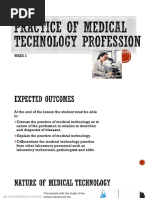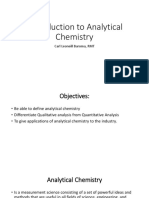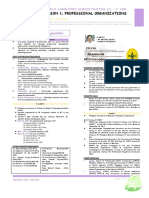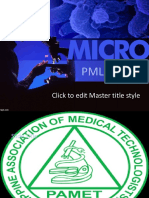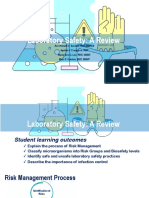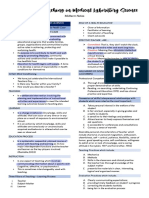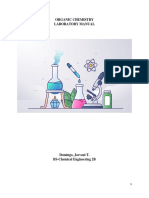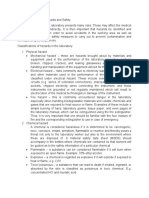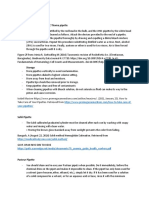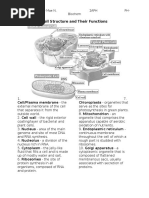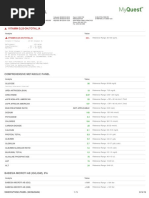0 ratings0% found this document useful (0 votes)
109 viewsPMLS Lesson 5
PMLS Lesson 5
Uploaded by
Althea EspirituThe document discusses the curriculum for Medical Technology/Clinical Laboratory Science education. It defines curriculum and outlines the general education and professional courses required. The professional courses include topics like principles of medical laboratory science, clinical laboratory assistance, phlebotomy, community and public health, cytogenetics, human histology, and clinical bacteriology. These courses aim to develop the necessary knowledge, skills, and professionalism to practice as a medical technologist. The curriculum is regulated by the Commission on Higher Education and outlined in the CHED Memorandum Order No. 13.
Copyright:
© All Rights Reserved
Available Formats
Download as DOCX, PDF, TXT or read online from Scribd
PMLS Lesson 5
PMLS Lesson 5
Uploaded by
Althea Espiritu0 ratings0% found this document useful (0 votes)
109 views7 pagesThe document discusses the curriculum for Medical Technology/Clinical Laboratory Science education. It defines curriculum and outlines the general education and professional courses required. The professional courses include topics like principles of medical laboratory science, clinical laboratory assistance, phlebotomy, community and public health, cytogenetics, human histology, and clinical bacteriology. These courses aim to develop the necessary knowledge, skills, and professionalism to practice as a medical technologist. The curriculum is regulated by the Commission on Higher Education and outlined in the CHED Memorandum Order No. 13.
Original Description:
notes
Original Title
PMLS LESSON 5
Copyright
© © All Rights Reserved
Available Formats
DOCX, PDF, TXT or read online from Scribd
Share this document
Did you find this document useful?
Is this content inappropriate?
The document discusses the curriculum for Medical Technology/Clinical Laboratory Science education. It defines curriculum and outlines the general education and professional courses required. The professional courses include topics like principles of medical laboratory science, clinical laboratory assistance, phlebotomy, community and public health, cytogenetics, human histology, and clinical bacteriology. These courses aim to develop the necessary knowledge, skills, and professionalism to practice as a medical technologist. The curriculum is regulated by the Commission on Higher Education and outlined in the CHED Memorandum Order No. 13.
Copyright:
© All Rights Reserved
Available Formats
Download as DOCX, PDF, TXT or read online from Scribd
Download as docx, pdf, or txt
0 ratings0% found this document useful (0 votes)
109 views7 pagesPMLS Lesson 5
PMLS Lesson 5
Uploaded by
Althea EspirituThe document discusses the curriculum for Medical Technology/Clinical Laboratory Science education. It defines curriculum and outlines the general education and professional courses required. The professional courses include topics like principles of medical laboratory science, clinical laboratory assistance, phlebotomy, community and public health, cytogenetics, human histology, and clinical bacteriology. These courses aim to develop the necessary knowledge, skills, and professionalism to practice as a medical technologist. The curriculum is regulated by the Commission on Higher Education and outlined in the CHED Memorandum Order No. 13.
Copyright:
© All Rights Reserved
Available Formats
Download as DOCX, PDF, TXT or read online from Scribd
Download as docx, pdf, or txt
You are on page 1of 7
PRINCIPLES OF MEDICAL LABORATORY SCIENCE
LESSON 5: MEDICAL TECHNOLOGY/CLINICAL LABORATORY
SCIENCE EDUCATION
CURRICULUM learners/students have to achieve
Curriculum comes from the and learn
Latin word through the use of planned
currere which means to run. instructional processes
and other learning implements in
DEFINITION OF a specific period.
c) Consists of a planned process of
CURRICULUM:
measurement,
A. According to Glossary of
assessment, and evaluation to
Educational Reforms,
gauge student
curriculum refers to the
learning.
knowledge and skills students
d) Is designed for students
are expected to learn, which
include the learning the
standards or learning objectives
they are expected to meet. the Medical Technology Curriculum
units and lessons that teacher Commission on Higher Education
teach, the assignments and (CHED)
projects given to students; the -established on May 18 1994 .
book materials; videos, through Republic Act No. 7722
presentations, and readings use (Higher Education Act of 1992)
in a course; and the test, -CHED is the government
assessments and other methods agency under the Office of the
used to evaluate student President
learnings. -Covers higher education both
B. Curriculum refers to the means public and of the Philippines that
and materials with which covers institutions of higher e
students interact for the purpose ducation both public and private.
of achieving identified -It is tasked to organize and
educational outcomes. appoint members of the technical
C. According to John Dewey, panel for each
curriculum is a continuous discipline/program area.
reconstruction, moving from the Under CHED is the
child's present experience out Technical Commitee for
into that represented by the Medical Technology
organized bodies of truth that we Education (TCMTE)
call studies. TCMTE- assist the
D. According to the Indiana commission in setting standards
Departmnet of Education, among institutions offering Bachelor of
curriculum refers to the planned Science in Medical
interaction of students with Technology/Medical Laboratory
instructional content, Science programs in monitoring
materials resources and and evaluating such institutions.
processes for evaluating -BSMT/BSMLS- is a four year
the attainment of educational program consisting of general
objectives. education and professional
courses.
In summary, curriculum: -Fourth Year is dedicated to the
a) Is systematic and organized students internship in CHED-
b) Explicitly states outcomes accredited training laboratories
(knowledge, skills) the
PRINCIPLES OF MEDICAL LABORATORY SCIENCE
LESSON 5: MEDICAL TECHNOLOGY/CLINICAL LABORATORY
SCIENCE EDUCATION
affliated with their college/
department.
CHED Memorandum Order
(CMO) No. 13, series of 2017 PROFESSIONAL
(Policies, Standards and COURSES:
Guidelines for Bachelor of
Science in Medical 1. Principles of Medical
Technology/Medical Laboratory Science 1:
Laboratory Science program) Introduction to Medical
-CMO contains goals, program Laboratory Safety, and Waste
outcomes, performance Management
indicators and the minimum Deals with the basic
course offerings. concepts and principles
-this new CMO is compliant related to the Medical
with K-12 Curriculum. Technology/Medical
Laboratory Science
profession.
GENERAL EDUCATION It emphasis is on the
COURSES curriculum, practice of
General Education (GE) the profession, clinical
-aims to develop humane laboratories, continuing
individuals that have a deeper professional education,
sense of self and acceptance of biosafetypractices and
others. waste management
2. Principles of Medical
GE COURSES: Laboratory Science 2:
Clinical Laboratory
1. Understanding the Self Assistance and Phlebotomy
2. Readings in Philippine History Clinical Laboratory
3. The Contemporary World Assistance encompasses
4. Mathematics in the Modern World the concepts and
5. Purposive Communication principles of different
6. The Life Works of Rizal assays performed in the
7. Science Technology and Society clinical laboratory.
8. Art Appreciation Phlebotomy deals with
9. Ethics the basic concepts,
principles and application
of the standard
PROFESSIONAL COURSES
procedures in blood
-to develop the knowledge,
collection, transport and
technical competence,
processing. It also
professional attitude and values
involves the study of pre-
necessary to practice and meet
analytic, analytic and
the demands of the profession.
post-analytic variables
-critical thinking, skills,
that affect reliability of
decision-making skills,
test results.
interpersonal skills,
3. Community and Public
collaboration and teamwork.
Health for MT/MLS
This course involves the
study of foundations of
PRINCIPLES OF MEDICAL LABORATORY SCIENCE
LESSON 5: MEDICAL TECHNOLOGY/CLINICAL LABORATORY
SCIENCE EDUCATION
community health that Staining
include human ecology, Mounting of
demography and stained tissue
epidemiology. It for microscopic
emphasizes the examination
promotion of community, Performing
public and environmrntal biosafety and
health and the immersion waste
and interaction with management
people in the community 7. Clinical Bacteriology
4. Cytogenetics This course deals with the
This course is focused on study of the physiology and
the study of the concepts morphology of bacteria and
and principles of heredity their role in infection and
and inheritance which immunity.
include genetic Preparation of Culture
phenomena, sex Media
determination and genetic Collection of Specimen
defect rooted in Preparation of bacterial
inheritance, among smear
others. Staining of smear
It also discusses the Inoculation of specimen
abnormalities ad genetic on culture media
disorders involving the Characterization of
chromosomes and nucleic colonies of bacteria
acids (DNA and RNA). growing in culture media
5. Human Histology Performing different
This course deals with the biochemical tests for
study of the fundamentals identification of
of cells, tissues, and bacteria
organs with emphasis on Biosafety and waste
microscopic structures, management
characteristics, Quality assurance and
differences, and quality control
functions. Antimicrobial
6. Histopathologic Techniques susceptibility testing
with Cytology 8. Clinical Parasitology
This course covers the This course is concerned
basic concepts and with the study of animal
principles of disease parasites in humans and
processes, etiology and their medical significance
the development of in the country.
anatomic, microscopic Its emphasis on
changes brought about by pathophysiology,
the disease process. epidemiology, life cycle,
Tissue prevention and disease
processing control and identification of
Cutting of ova and/or adult worms and
processed other forms seen in
tissue
PRINCIPLES OF MEDICAL LABORATORY SCIENCE
LESSON 5: MEDICAL TECHNOLOGY/CLINICAL LABORATORY
SCIENCE EDUCATION
specimens submitted for control, preparation of
diagnostic purposes. policy and procedure
Microscopic identification manuals, and other
of diagnostic features of activities necessary to
different groups of parasites maintain a well-functioning
pathogenic to man (e.g. laboratory.
nematodes, trematodes, 12. Medical Technology Laws
cestodes, protozoa, and Bioethics
plasmodium, among others) This course encompasses
Different methods of various laws, administrative
preparing smears for orders, and other approved
microscopic examination legal documents related to
(Direct Fecal Smear, Kato- the practice of Medical
Katz, among others). Technology/Medical
9. Immunohematology and Laboratory Science in the
Blood Bank Philippines.
This course tackles the Bioethics looks into the
concepts of inheritance, study of ethics as applied to
characterization and health and health care
laboratoryidentification o delivery and human life in
red cells antigens and their general.
corresponding antibodies. Different bioethical
ABO and Rh Typing principles, philosophical
Coombs Test principle, virtues and norms
Blood Donation and the Code of Ethics of
Process Medical Technology also
Compatibility Testing discussed.
Transfusion Reaction 13. Hematology 1
Work-up This course deals with the
Preparation of RBC study of the concepts of
suspension blood as tissue. Formation,
10. . MYCOLOGY AND metabolism of cells,
VIROLOGY laboratory assays,
mycology (study of fungi), correlation with pathologic
virology (study of viruses). conditions, special
Emphasis on epidemiology, hematology evaluation are
laboratory identification given emphasis.
and characterization, Quality assurance and
prevention and control. quality control in
11. Laboratory Management hematology laboratory as
This course looks into the well as bone marrow
concepts of laboratory studies are also discussed.
management which are 14. Hematology 2
planning, organizing, This course deals with the
staffing, directing and concepts and principles of
controlling as applied in hemostasis and
clinical laboratory setting. abnormalities involving red
It also tackles the process of blood cells(RBC), white
solving problems, quality blood cells and platelets.
assurance and quality
PRINCIPLES OF MEDICAL LABORATORY SCIENCE
LESSON 5: MEDICAL TECHNOLOGY/CLINICAL LABORATORY
SCIENCE EDUCATION
Laboratory identification of Therapeutic drug
blood cells abnormalities, monitoring and
quantitative measurement laboratoryanalyses of drugs
ofcoagulation factors and and substances of abuse as
disease correlation are well as toxic substances are
emphasized. also emphasized.
15. Clinical Microscopy 18. Seminar 1 and 2
This course focuses on the This course is taken during
study of urine, and other the student's fourth year in
body fluids (excluding the program together with
blood).It includes the the internship training.
discussion of their It deals with current
formation,laboratory laboratory analyses used in
analyses, disease processes, the practice of medical
and clinical correlation of technology.
laboratory results. 19. . Molecular Biology and
16. Clinical Chemistry 1 Diagnostics
This course encompasses Molecular Biology deals
the concepts and principles with the nucleic acid and
of physiologically active protein molecule interaction
soluble substances and within the cell to promote
waste materials present in proper growth, cell division
body fluids, particularly in and development.
the blood. It covers the molecular
The study includes mechanisms of DNA
formation, laboratory replication, repair,
analyses, reference values transcription, translation,
and clinical correlation with protein synthesis and gene
pathologic conditions. regulation.
The course also looks into This course focused on the
instrumentation and concepts, principles, and
automation, quality application of molecular
assurance and quality biology in clinical
control. laboratory. It deals with the
17. Clinical Chemistry 2 application of different
This course is a molecular techniques as
continuation of Clinical tool in the diagnosis of
Chemistry 1 and deals with diseases.
the concepts and principles
of physiologically active
soluble waste materials
present in body fluids, RESEARCH COURSES
particularly in the blood. Research courses required in the
It covers the study of BSMT/BSMLS programs are:
endocrine glands and Research 1: Introduction to
hormones and their Laboratory Science Research
formation, laboratory -Research 1 deals with the basic
analyses, and clinical concepts and principles of
correlation. research as applied in Medical
PRINCIPLES OF MEDICAL LABORATORY SCIENCE
LESSON 5: MEDICAL TECHNOLOGY/CLINICAL LABORATORY
SCIENCE EDUCATION
Technology/Clinical Laboratory exceeding a total of 1664
Science.Ethical Principles as hours in one year
applied to research is also
emphasized. LICENSURE EXAMINATION
Research 2 : Research Paper The Medical Technologist
and Writing and Licensure Examination is
Presentation. conducted in order to identify
-Research 2- covers the graduates who possess the basic
methodology, of the research, qualifications or the minimum
writing the research and conceptual skills and technical
presentation of the finished and competencies to perform the tasks
completed research in a formal with minimum errors.
forum. Professional Regulation
Commission (PRC) is the
CLINICAL INTERNSHIP government agency, under the
TRAINING office of the President of the
Clinical Internship Training is Philippines is tasked to administer
taken during the student's licensure examinations to
fourth year in the program. different professionals.
Only those who have Professional Regulatory Board
completed and passed all the (PRB) for Medical Technology is
academic and institutional tasked to prepare and administer
requirements for the first the written licensure examinations
three years of the program for graduates qualified to take the
and other requirements as examination.
specified in the official PRB is composed of a chairperson-
documents of the institution, licensed pathologist 2 members -
college and/or departments registered medical technologist
are qualified for internship. All members of the PRB are
Physical and Laboratory required to be holders of PRC
Examinations license Medical Technologist
This intensive training aims Licensure Examinations given
to apply the theoretical twice a year (March and August)
aspects of the profession into
practice. Listed below are some of the provisions
Students are assigned to included in Republic Act 5527, “The
CHED-accredited clinical Medical Technology Act of 1969” in
laboratories affliated with relation to licensure examinations:
their academic institution on a 1. Courses included in the licensure
6 months or one year rotation. examinations and their
Intern is required to render 32 corresponding weights are as
hours of duty per week not follows:
Clinical Chemistry- 20%
Microbiology and Parasitology-
20%
Hematology - 20%
Blood Banking and Immunology
and Serology - 20%
Clinical Microscopy - 10%
Histopathologic Techniques - 10%
PRINCIPLES OF MEDICAL LABORATORY SCIENCE
LESSON 5: MEDICAL TECHNOLOGY/CLINICAL LABORATORY
SCIENCE EDUCATION
(MT Laws and Bioethics and Laboratory
Management -not written in R.A.5527,
but are now included in the board exam)
2. To pass the exam, an examinee
must:
Receive a general weighted average
of 75%
Have no rating below 50% in any
major courses
Pass in at least 60% of the courses
computed according to their
relative weights
3. LICENSURE EXAMINATION
If an EXAMINEE passed the
examination and is 21 years old
above, he or she will be issued a
certificate of registration and a
PRC card as a licensed medical
technologist.
If an examinee is younger than 21
years old,he/she will be registered
as a professional after his 21st
birthday.
If an examinee failed to pass the
licensure examination three times,
he or she needs toenrol in a
refresher course before taking
theexamination.
If an examinee failed to pass the
examination but garnered a
general weighted average of 70-
74%, he or she may apply as a
medical laboratory technician.
You might also like
- Lesson 8Document48 pagesLesson 8Xigna Milano AmoresNo ratings yet
- Basic Concepts On Laboratory Biosafety and BiosecurityDocument27 pagesBasic Concepts On Laboratory Biosafety and BiosecurityAlmay Minka GamayonNo ratings yet
- PMTP1 - Unit 1-3 HandoutDocument8 pagesPMTP1 - Unit 1-3 HandoutARVINE JUSTINE CORPUZ100% (1)
- Course Syllabus - Histology LabDocument2 pagesCourse Syllabus - Histology LabFearless Angel100% (1)
- 11 - HCWMDocument7 pages11 - HCWMGrace FloresNo ratings yet
- PMLS L9 Professional OrganizationsDocument4 pagesPMLS L9 Professional OrganizationsJerica Basco LayosNo ratings yet
- Lesson 10 - Continuing Professional DevelopmentDocument3 pagesLesson 10 - Continuing Professional DevelopmentCookie MonsterNo ratings yet
- PMLS 1 Module 11Document10 pagesPMLS 1 Module 11Chyle MaeNo ratings yet
- PMLS 1Document14 pagesPMLS 1AelwenNo ratings yet
- Module # 2 Medical Terminologies and Abbreviations and Ethics in The ProfessionDocument6 pagesModule # 2 Medical Terminologies and Abbreviations and Ethics in The ProfessionJonice NavarroNo ratings yet
- Defining The MT ProfessionDocument26 pagesDefining The MT ProfessionLady Juliana MarieNo ratings yet
- WEEK 3 Introduction To MLS ProfessionDocument25 pagesWEEK 3 Introduction To MLS ProfessionHANAH LORAINE LAUREANo ratings yet
- Transes Anaphy LEC (Activity 5 HISTOLOGY)Document6 pagesTranses Anaphy LEC (Activity 5 HISTOLOGY)Reign Saplaco100% (2)
- Defining The Practice of Medical Technolog1 ReviewerDocument2 pagesDefining The Practice of Medical Technolog1 ReviewerZAIRA N. CNo ratings yet
- PMLS1 PasmethDocument4 pagesPMLS1 Pasmeth1E - EGOT, FRANCEE ANGELA B.No ratings yet
- Analytical Chemistry 1 (Autosaved)Document37 pagesAnalytical Chemistry 1 (Autosaved)cheewyyyyNo ratings yet
- Jaycommss Principles of Medical Laboratory Science Practice 1Document73 pagesJaycommss Principles of Medical Laboratory Science Practice 1Ces GarciaNo ratings yet
- Mls1 Medical Terminologies Sept 1Document5 pagesMls1 Medical Terminologies Sept 1Lian Marie ViñasNo ratings yet
- PMLS His Reviewer Midterms Lessons 1Document14 pagesPMLS His Reviewer Midterms Lessons 1Mark vincent EspinosaNo ratings yet
- Endocrine System (Midterm)Document6 pagesEndocrine System (Midterm)edceljero127No ratings yet
- PMLS 1ppt 1Document60 pagesPMLS 1ppt 1Reon PytoNo ratings yet
- Anatomy and Physiology With Pathophysiology TransesDocument10 pagesAnatomy and Physiology With Pathophysiology Transeshezekiah minNo ratings yet
- Trans - Mls 101 - Chapter 2Document3 pagesTrans - Mls 101 - Chapter 2Camille De CastroNo ratings yet
- Lesson 2 Practice of Medical Technology in The PhilippinesDocument6 pagesLesson 2 Practice of Medical Technology in The PhilippinesGianneCarloGomedNo ratings yet
- PMLS 2 PrelimsDocument55 pagesPMLS 2 PrelimsCassey Stephane PinedaNo ratings yet
- Defining The Practice of Medical Technology or Clinical Laboratory Science ProfessionDocument27 pagesDefining The Practice of Medical Technology or Clinical Laboratory Science ProfessionKianna TicsayNo ratings yet
- PMLS2 LEC - Circulatory SystemDocument4 pagesPMLS2 LEC - Circulatory SystemCorinne Bautista RenivaNo ratings yet
- Alinsunurin - PMLS2 - Prelim ExamDocument10 pagesAlinsunurin - PMLS2 - Prelim ExamFrankenstein MelancholyNo ratings yet
- Principles of Medical Technology Practice 1Document6 pagesPrinciples of Medical Technology Practice 1Maw BerryNo ratings yet
- CM1 Cu2 Introduction To Management and Organizational SystemDocument10 pagesCM1 Cu2 Introduction To Management and Organizational SystemKEZIA GERONIMO100% (1)
- Psthe MidtermDocument6 pagesPsthe MidtermTrisha GolesNo ratings yet
- Lesson 10Document37 pagesLesson 10Xigna Milano AmoresNo ratings yet
- PMLS Lesson 7Document2 pagesPMLS Lesson 7Althea EspirituNo ratings yet
- PMLS 1 Topic 8.0 TransDocument6 pagesPMLS 1 Topic 8.0 TranslalaNo ratings yet
- Kami Export - LECTURE - Nature of The Clinical Laboratory PDFDocument21 pagesKami Export - LECTURE - Nature of The Clinical Laboratory PDFnicoNo ratings yet
- PMLS Lesson 1Document8 pagesPMLS Lesson 1seayn100% (1)
- Activity 2 Intro Tissue SectioningDocument4 pagesActivity 2 Intro Tissue SectioningEricka Genove100% (2)
- CPH LecDocument12 pagesCPH LecLuningning UmarNo ratings yet
- S CHEM011 Inorganic and Organic Chemistry TraditionalDocument10 pagesS CHEM011 Inorganic and Organic Chemistry TraditionalJasmine CatanaNo ratings yet
- AUBF Lec - Lab Safety - QADocument12 pagesAUBF Lec - Lab Safety - QALeinard ClaveroNo ratings yet
- NervousDocument19 pagesNervousEmmanuel A. GalvanNo ratings yet
- Skeletal SystemDocument52 pagesSkeletal SystemHarish musictryNo ratings yet
- 01 - BIOE 211 - Nature of Statistics and Data ProcessingDocument26 pages01 - BIOE 211 - Nature of Statistics and Data ProcessingJhelloNo ratings yet
- Domingo, Joevani T. (Laboratory Manuals)Document141 pagesDomingo, Joevani T. (Laboratory Manuals)Joevani DomingoNo ratings yet
- Introduction To MLS 1Document11 pagesIntroduction To MLS 1Thea sam penafloridaNo ratings yet
- Lesson 4Document6 pagesLesson 4doldol ocampoNo ratings yet
- SHS The HUMAN BODY An OrientationDocument81 pagesSHS The HUMAN BODY An OrientationRhena Togores100% (1)
- 1 RA5527 (Medical Technology Act)Document45 pages1 RA5527 (Medical Technology Act)REYMAR VICU BRAVONo ratings yet
- Manglo - Prelims Reviewer in Medtech LawsDocument24 pagesManglo - Prelims Reviewer in Medtech LawsRhaine Alyssa MangloNo ratings yet
- PMLS 2 Lesson 1Document4 pagesPMLS 2 Lesson 1Void MelromarcNo ratings yet
- (Lec) (Tran) ANCH1111 Introduction To Analytical ChemistryDocument3 pages(Lec) (Tran) ANCH1111 Introduction To Analytical ChemistryJOSGE EIN KAREM SANCHEZNo ratings yet
- ANAPHY LEC PRELIMS NOTES by NOVERO KEN BMLS2 1Document55 pagesANAPHY LEC PRELIMS NOTES by NOVERO KEN BMLS2 1Marcus Randielle FloresNo ratings yet
- PMLS 2 LaboratoryDocument11 pagesPMLS 2 LaboratoryJanna EchavezNo ratings yet
- PMLS Chapter 2 - Defining The Practice of He Medical Technology - Clinical Laboratory Science ProfessionDocument8 pagesPMLS Chapter 2 - Defining The Practice of He Medical Technology - Clinical Laboratory Science ProfessionRamela Nicole AldaveNo ratings yet
- Course Outline ParasitologyDocument6 pagesCourse Outline ParasitologyNichole SilverioNo ratings yet
- Lymphatic System Transes 1Document8 pagesLymphatic System Transes 1Sophia Margarette CawalingNo ratings yet
- Act.1 RQ 2 Pipettes and Others 1-3Document3 pagesAct.1 RQ 2 Pipettes and Others 1-3Francis Valdez100% (1)
- PH-BIOCHEM Cell Structure and Their FunctionsDocument2 pagesPH-BIOCHEM Cell Structure and Their FunctionsKimberly Mae MesinaNo ratings yet
- Module 2 CytogeneticsDocument17 pagesModule 2 CytogeneticsFrances Riane SimoyNo ratings yet
- Group 1 A1Document2 pagesGroup 1 A1Althea EspirituNo ratings yet
- Biochem LabDocument7 pagesBiochem LabAlthea EspirituNo ratings yet
- Chapter 6 Ra 11166 NotesDocument9 pagesChapter 6 Ra 11166 NotesAlthea EspirituNo ratings yet
- CAPILLARY PUNCTURE or Skin Puncture Type of Equipment Fro Capillary Specimen CollectionDocument3 pagesCAPILLARY PUNCTURE or Skin Puncture Type of Equipment Fro Capillary Specimen CollectionAlthea EspirituNo ratings yet
- LESSON 6 Physiological Variables That Influence LaboratoryDocument5 pagesLESSON 6 Physiological Variables That Influence LaboratoryAlthea EspirituNo ratings yet
- Lesson 5 Venipuncture Steps NotesDocument3 pagesLesson 5 Venipuncture Steps NotesAlthea EspirituNo ratings yet
- Paul. 2004. Olanzapine in The Management of Bipolar DisorderDocument18 pagesPaul. 2004. Olanzapine in The Management of Bipolar DisorderRuth RachmawatyNo ratings yet
- Normothermia Audit Tool: AHRQ Safety Program For SurgeryDocument3 pagesNormothermia Audit Tool: AHRQ Safety Program For SurgeryDewi ListyoriniNo ratings yet
- Scopingreporton Antimicrobialresistancein IndiaDocument146 pagesScopingreporton Antimicrobialresistancein Indiafarooq shikhNo ratings yet
- DR Sumit Garg Projec-IECDocument10 pagesDR Sumit Garg Projec-IECkamlesh yadavNo ratings yet
- NKTIDocument6 pagesNKTIBrian TayaoNo ratings yet
- Lg2zjojhkaxo3w0z3ijetbbsDocument2 pagesLg2zjojhkaxo3w0z3ijetbbsitsverma 12No ratings yet
- Combined QDocument46 pagesCombined QRoh JitenNo ratings yet
- Ineffective Tissue PerfusionDocument1 pageIneffective Tissue PerfusionEuanne Orellano85% (13)
- Espen Guideline Clinical Nutrition Pancreatitis 1707936235Document18 pagesEspen Guideline Clinical Nutrition Pancreatitis 1707936235CatherinavcuNo ratings yet
- GREAT SupremeHealth and GREAT TotalCare Brochure (Full) Version 3 - 2022Document22 pagesGREAT SupremeHealth and GREAT TotalCare Brochure (Full) Version 3 - 2022Wenwei ChionhNo ratings yet
- ConstipationDocument2 pagesConstipationPrashant jainNo ratings yet
- Breast and Lung CancerDocument141 pagesBreast and Lung CancerabdurehmanNo ratings yet
- Nasogastric NG Tube Insertion OSCE GuideDocument17 pagesNasogastric NG Tube Insertion OSCE Guidedungek30No ratings yet
- Surgical MenopauseDocument5 pagesSurgical MenopauseSusan HepziNo ratings yet
- PENYAKIT HATI (Uas)Document27 pagesPENYAKIT HATI (Uas)Cinsy PaskalineNo ratings yet
- RD Tool Post Mortem CareDocument2 pagesRD Tool Post Mortem CareDave RondarisNo ratings yet
- English FinalsDocument28 pagesEnglish FinalsMark M. Alipio100% (1)
- The Pathology Lab: Blood ScienceDocument1 pageThe Pathology Lab: Blood SciencejeanbeanjellymanNo ratings yet
- Thesis Protocol: Suba Arul Devi (Post Graduate Student, Department of RadiodiagnosisDocument21 pagesThesis Protocol: Suba Arul Devi (Post Graduate Student, Department of RadiodiagnosisJagan MaxNo ratings yet
- Saying No To PatientsDocument6 pagesSaying No To PatientsCristina SeNo ratings yet
- Dermatology Class NotesDocument48 pagesDermatology Class Notesapi-26938624100% (7)
- Medication Guide Byetta (Exenatide) Injection: Reference ID: 3031125Document8 pagesMedication Guide Byetta (Exenatide) Injection: Reference ID: 3031125Marium Mohamed AliNo ratings yet
- DAN BLS CPR Student HandbookDocument109 pagesDAN BLS CPR Student HandbookNicole Sue BucatNo ratings yet
- For Immediate ReleaseDocument2 pagesFor Immediate ReleaseNathan GayleNo ratings yet
- Web Quiz Somatoform and Dissociative Disorders Chapter 6Document4 pagesWeb Quiz Somatoform and Dissociative Disorders Chapter 6IvaNova IvelinaNo ratings yet
- 2020 - Obstetric Referral Pattern in A Tertiary Care Centre A Prospective Observational Study, IndiaDocument7 pages2020 - Obstetric Referral Pattern in A Tertiary Care Centre A Prospective Observational Study, IndiaTaklu Marama M. BaatiiNo ratings yet
- Cardiovascular Fitness & ExerciseDocument33 pagesCardiovascular Fitness & Exercisewaqar aliNo ratings yet
- Pawel Swierczynski Healthinfo PDFDocument5 pagesPawel Swierczynski Healthinfo PDFPaul ValinorNo ratings yet
- 2022 10 EMBASE JournalsDocument520 pages2022 10 EMBASE JournalsParul NandaNo ratings yet
- Respitide DXM PDFDocument62 pagesRespitide DXM PDFImmanuel Jeffri PaianNo ratings yet











